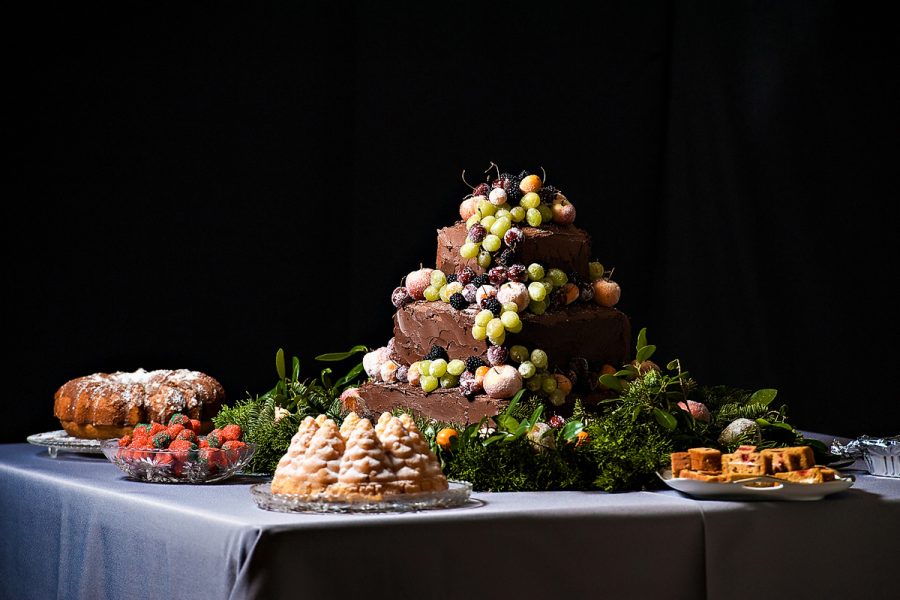Why A Potluck?
We decided early on to have a potluck dinner reception. It was largely born out of necessity. We had a huge guest list, and we didn’t want to try to pare down the list to make a per-plate cost fit into the budget. People were our priority, so we needed a way to accommodate everyone.
We also knew that our wedding would be formal. The church is both of our first loves and Tim’s life’s work; we didn’t for one second ever dream of marrying any other way than in a High Nuptial Mass by candlelight. We also had our hearts set on a sit-down dinner reception. We’re really not dance-party people, and we’re absolutely not small-bite canapé people. We’re pass-the-gravy-please and I’ll-have-seconds-on-the-turkey people. We believe that there’s a reason why the central ritual of our religion is a symbolic shared meal, and we wanted to honor that. We believe there is spiritual power in the consumption of food made in love, and that’s the sort of thing that just can’t be bought.
Figuring Out Logistics
First, we looked at the logistics to see if the potluck was possible. We started by asking ourselves some hard questions about whether or not we could pull this off. I think to make a wedding potluck work, you need to have a mostly local crowd, and you need to have folks that “get” potlucks. Fortunately, our church does potlucks about once a month, so we knew we had a core guest list made up of potluck veterans. Potluck is hard-baked into the Episcopalian DNA.
Then we approached the key people we would need to make it happen—the kitchen ladies. If your church has a kitchen, I assure you, you have kitchen ladies, even if they’re not all women! We pitched the idea to our kitchen mafia and asked them if they would help. They loved the idea, and one of them even volunteered to captain the kitchen for the night. Their expertise paid off—it was one of the kitchen experts who came up with the idea to have the kitchen open that afternoon so guests could drop off their dishes ahead of time.
Once we had the kitchen ladies on board and were confident we had the right crowd, we counted everything in the church to find out if we had the materials we needed. Whatever was missing, we rented. I hired extra servers from the bartending company to be “kitchen minions,” which pleased the kitchen ladies to no end. This was probably the best money we spent, after hiring Holly our photographer. Having enough hands is crucial, and it was a bonus to be able to get folks who were experienced servers that I could count on to show up on time, dressed appropriately. Once the details were in place, we briefed our priest on our plan just to be sure we had top-cover. The party was ON!
Getting The Guests On Board
After that, it was a question of whether our guests would go for the idea. I have always thought the key to keeping guests happy under any circumstances lies in managing expectations. People want to know what to wear, what time to show up, what will happen, and what is expected of them. It’s been my experience that most people happily get on board with your plans provided they know enough information, especially those that love you. We thought about restricting the potluck plans to only to those we actually expected to participate, but based on my “full disclosure” philosophy, I decided to open it up to everyone and see what happened.
Holly called our wedding “Couture Potluck,” and I think that captures it perfectly. To help shape everyone’s expectations, I used the social cues embedded in wedding etiquette to let our guests know that the event would be a formal one, but just one that happened to feature a potluck. This meant making some choices I would not have made otherwise in order get across the “Couture Potluck” theme, like formal invitations, a wedding website, and formal seating charts complete with hand-lettered escort cards.
I sent out the invitations on the early side, to give plenty of time for Q&A. Everyone got a creamy-paper formal invitation (which I made myself using Meg’s APW tutorial—thanks Meg!) with an RSVP card, addressed with calligraphy I did by hand. I carefully selected wording that made it clear to the Episcopalians that the liturgy for the service would be very formal.
Enclosed in the invitation and printed on fancy-looking parchment paper was a letter that we wrote that explained our spiritual philosophy about shared meals, and how everyone was also invited to participate in the potluck if they choose. We poured our hearts out about how we loved shared holiday meals and how we wanted to evoke that same feeling for our wedding. We labored the point that everyone was invited the wedding no matter what, that the potluck was a totally separate thing and not something they needed to do if they wanted to come. At the bottom of the page was a section they could fill out and rip off with all the details if they wanted to play. It was important to have a separate RSVP vehicle for just the wedding—one that didn’t mention the potluck anywhere so people wouldn’t feel obliged to tick a box—and a totally separate RSVP vehicle for the potluck itself. The goal was to avoid a sense of obligation. We feared the perception that a covered dish was the “cost of entry” for our wedding. We also wanted everyone to know what he or she was getting into when they RSVP’d for our wedding. I’m sure a few people felt the potluck was inappropriate, and this way they could opt out of the entire affair from the get-go if they felt that way.
Note: You can download a Christian Version of the potluck letter, inspired by Haley and tim’s original, and a Secular version right here.
I also put in the letter that we would be collecting recipes ahead of time to bind into a recipe book for guest gifts on the day of the wedding. I wasn’t sure how many people would actually want to participate, but I reasoned that based upon the RSVPs I got and what dishes folks sent me the recipes for, that I would have some sense of what we were working with, and whether we needed to order more food from the local deli. To “anchor” the meal and make sure there was enough main dish for everyone, we placed an order for some honey-baked hams and bought a few frozen turkeys on sale at the local market right after Christmas.
Within a week, the RSVP cards started to roll in. I practically skipped to the mailbox every day giddy with excitement. Those creamy little envelopes with my shaky calligraphy came back stuffed with recipes. Some handwritten, some typed on old typewriters, some computer printouts, all of them covered with the fingerprints of love. We even received a few cell phone photos of ancient index cards written out longhand by grandmothers. Many of them came with little stories about their past and the loved ones who had made them who had long since gone to heaven, and what the dish meant their family. In the end, far more people participated in the potluck than I ever expected; of the 220 guests who RSVP’d they were coming, we had about seventy-five families who brought a dish, and some brought multiple dishes. Because so many people had participated in the recipe exchange, we mostly knew what was coming, and when guests asked in the weeks just before the wedding what they could bring, we were able to suggest types of dishes that we needed most.
Delicious, Delicious Setup
The Thursday before the wedding we set up the parish hall and roasted the grocery store turkeys in the church’s ovens. All the rental items were delivered, and we hung the decorations and set up the buffet tables. The turkeys were carved, tucked into buffet pans, and stashed in the fridge. We split one long buffet into two so there could be two start points, and mapped out sections for mains, salads, sides, and set up separate tables for desserts. The kitchen experts went through the potluck roster and staged serving dishes accordingly. The church smelled like roast turkey. All was ready, and we took all day on Friday to spend time with our out of town guests.
The day of the wedding, Saturday, the kitchen opened hours before the ceremony. As dishes arrived, the kitchen crew re-plated dishes on the church’s serveware, washed the dish it showed up in, and sent it home clean. The kitchen closed for about an hour so they could go home and change for the wedding, and then reopened for the last hour prior to the ceremony for the remaining dishes. This meant no one needed to balance a casserole on their lap during the ceremony or leave a dish in their car. Just minutes before the procession, the kitchen mafia dashed into the back pews, giggling conspiratorially. During the actual ceremony, the waitstaff we hired watched over everything and took care of any stragglers.
We were lucky that our church had an extra reception space for cocktail hour separate from the parish hall; this kept everyone out of the way while the buffet was set up. While the guests mingled and had drinks, the kitchen crew and the waitstaff sprung into action. The kitchen boss directed the rewarming as needed, and the waitstaff ran the dishes out to the buffet. This process consumed the entire cocktail hour. I had planned to truncate cocktail hour if the ceremony ran long (which it did), but in actuality the kitchen staff needed every minute of that hour. When the board was laid, we let everyone find their seats in the hall, said grace, and a friend directed tables to the buffet one at a time and cruised the room with bottles of wine.
A Meal Of Love
Guests raved. People left the buffet with plates piled high like it was a family Thanksgiving. Several made repeat visits for seconds. Everyone talked about the dishes, and laughed at the little stories I included in the recipe book. We let dinner run on as long as it felt natural to do so; the focus of the night for us wasn’t really dancing because we’re not really dancers, so this was no sacrifice. We didn’t throw bouquets or garters or have speeches. We all just sat and ate and told stories and drank toasts; it was like being at a massive family holiday dinner. At the end of dinner we did cut the cake and do a first dance, mostly because I feared that there were guests that wouldn’t feel comfortable leaving unless those things happened first. Then I went back for a plate of turkey-and-gravy seconds.
A Note About Cleanup: The only other downside was cleanup, which was a bear. We wound up paying the waitstaff nearly two hours overtime to try to get all the dishes back into the kitchen and things returned to order. Looking back on it, this is the one thing I would do differently. I used mostly the church’s serving- and diningware, which meant everything had to be washed completely and put back into storage. The job wasn’t even fully complete until the next morning, and I spent the first morning of my married life doing dishes along with several of my friends in the church kitchen. In hindsight, I think it would have been worth the expense to have just rented all the dishes and serveware. Everything would have effortlessly matched, the rental company would have handled the setup, and all that would have been necessary at the end of the night would be to rinse and restack the dishes since the rental company I used offered a cleaning service. When I was originally quoted the cost, I balked because it seemed unnecessary. After all, the church had its own dishes. But now I think the savings in time and effort would have been well worth it.







